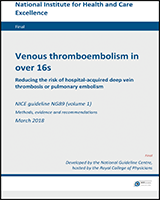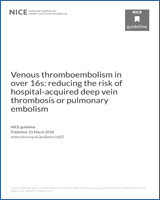NCBI Bookshelf. A service of the National Library of Medicine, National Institutes of Health.
National Guideline Centre (UK). Venous thromboembolism in over 16s: Reducing the risk of hospital-acquired deep vein thrombosis or pulmonary embolism. London: National Institute for Health and Care Excellence (NICE); 2018 Mar. (NICE Guideline, No. 89.)
December 2019: In recommendation 1.3.5 the British Standards for anti-embolism hosiery were updated because BS 6612 and BS 7672 have been withdrawn. August 2019: Recommendation 1.12.11 (1.5.30 in this document) was amended to clarify when anti-embolism stockings can be used for VTE prophylaxis for people with spinal injury.

Venous thromboembolism in over 16s: Reducing the risk of hospital-acquired deep vein thrombosis or pulmonary embolism.
Show detailsHospital-acquired venous thromboembolism (VTE), also known as hospital-acquired or hospital-associated thrombosis (HAT), covers all VTE that occurs in hospital and within 90 days after a hospital admission. It is a common and potentially preventable problem. VTE most frequently occurs in the deep veins of the legs or pelvis (a deep vein thrombosis). If it dislodges and travels to the lungs it is called a pulmonary embolism, which in some cases can be fatal.
Hospital-acquired VTE accounts for thousands of deaths annually in the NHS, and fatal pulmonary embolism remains a common cause of in-hospital mortality. HAT accounts for 50–60% of all VTE seen. In 2013–14 there were around 24,700 admissions for pulmonary embolism and 19,400 for DVT in England. In 2013, in England and Wales there were 2,191 deaths recorded as due to pulmonary embolism and 2,816 due to deep vein thrombosis. Treatment of non-fatal symptomatic VTE and related long-term morbidities is associated with a considerable cost to the health service.
People admitted to hospital have varying risk factors for VTE. The spectrum of VTE risk is broad, and understanding the scale of the problem has led to a paradigm shift in preventing and managing VTE in the NHS. In particular, patients now undergo VTE risk assessment as a routine event in all NHS care pathways. By July 2013, 96% of adult admissions to NHS-funded acute care hospitals were risk assessed compared with less than 50% of patients in July 2010.
VTE prophylaxis has been shown to reduce the incidence of DVT. It includes mechanical methods (such as anti-embolism stockings, foot impulse and intermittent pneumatic compression devices) and pharmacological treatments (such as heparin and other anticoagulant drugs).
This guideline is about reducing the risk of VTE in people over 16 years of age admitted to hospitals. It provides recommendations on the most clinically and cost effective measures to reduce the risk of VTE, while considering the potential risks of the various VTE prophylaxis options and patient preferences. It highlights the importance of risk assessment for VTE and for bleeding for all people being admitted and of clinical judgement in deciding on a prophylaxis strategy for each person at risk.
The 2018 update takes into account newer evidence and newer therapies and has been made more relevant for specific groups such as surgical sub-specialities, people with mental health conditions and pregnant women.
- Introduction - Venous thromboembolism in over 16sIntroduction - Venous thromboembolism in over 16s
Your browsing activity is empty.
Activity recording is turned off.
See more...
